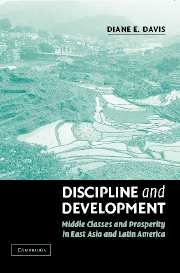Book contents
- Frontmatter
- Contents
- Preface
- DISCIPLINE AND DEVELOPMENT
- 1 An Introduction to Middle Classes, Discipline, and Development
- 2 Middle Classes and Development Theory
- 3 Discipline and Reward: Rural Middle Classes and the South Korean Development Miracle
- 4 Disciplinary Development as Rural Middle-Class Formation: Proletarianized Peasants and Farmer-Workers in Argentina and Taiwan
- 5 From Victors to Victims? Rural Middle Classes, Revolutionary Legacies, and the Unfulfilled Promise of Disciplinary Development in Mexico
- 6 Disciplinary Development in a New Millennium: The Global Context of Past Gains and Future Prospects
- Appendix A Cases, Comparisons, and a Note on Methodology and Sources
- Appendix B Defining the Middle Class: Notes on Boundaries and Epistemology
- Appendix C Tables
- Bibliography
- Index
Appendix B - Defining the Middle Class: Notes on Boundaries and Epistemology
Published online by Cambridge University Press: 31 July 2009
- Frontmatter
- Contents
- Preface
- DISCIPLINE AND DEVELOPMENT
- 1 An Introduction to Middle Classes, Discipline, and Development
- 2 Middle Classes and Development Theory
- 3 Discipline and Reward: Rural Middle Classes and the South Korean Development Miracle
- 4 Disciplinary Development as Rural Middle-Class Formation: Proletarianized Peasants and Farmer-Workers in Argentina and Taiwan
- 5 From Victors to Victims? Rural Middle Classes, Revolutionary Legacies, and the Unfulfilled Promise of Disciplinary Development in Mexico
- 6 Disciplinary Development in a New Millennium: The Global Context of Past Gains and Future Prospects
- Appendix A Cases, Comparisons, and a Note on Methodology and Sources
- Appendix B Defining the Middle Class: Notes on Boundaries and Epistemology
- Appendix C Tables
- Bibliography
- Index
Summary
Who are these middle classes that are hypothesized as so central to national development in this book, and what is the best way to study them as well as the state and class alliances they forge? These have been among the most difficult questions of this inquiry. Definitional quandaries about who constitutes the middle class and why have been among the most contentious and controversial themes in the study of society. Drawing boundaries around any class category is fraught with difficulties, as is theorizing their bases for action in the context of this boundary drawing. To be concerned with a class whose so-called objective foundations are considered fluid and unstable and which is characterized by extensive occupational diversity is to invite further controversy. Moreover, as Anthony Giddens and others have pointed out, one of the most interesting attributes of middle-classness is the absence of class identity or consciousness. The turn to poststructuralist analysis has added to the confusion over definitions and the debates over boundary drawing by raising valid and serious questions about the relative worth of objective versus subjective definitions of class. And if we also throw in the peculiarities of the developing world, where the middle class is in many ways a constantly moving target whose size, composition, and character change dramatically as the economy changes equally rapidly, the task is truly daunting.
- Type
- Chapter
- Information
- Discipline and DevelopmentMiddle Classes and Prosperity in East Asia and Latin America, pp. 363 - 368Publisher: Cambridge University PressPrint publication year: 2004



